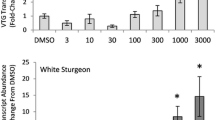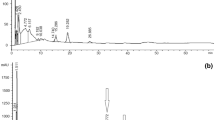Abstract.
An in vitro assay has been developed to screen for estrogenic activity of single chemicals or complex mixtures. This method combines primary hepatocyte cultures from the channel catfish (Ictalurus punctatus) with an enzyme-linked immunosorbant assay (ELISA) to detect and quantify the production of vitellogenin (VTG), a liver-derived, estrogen-induced lipoprotein. A variety of environmentally relevant chemicals and chemical mixtures were tested, including the polyaromatic hydrocarbon benzo(a)pyrene (BaP), the alkylphenolic surfactants 4-tert-octylphenol (OP) and p-nonylphenol (NP), the chlorinated insecticide o,p′-DDT, the plant derivative stigmastanol, and a number of waste waters from pulp and paper mills. In addition, the effects of estradiol (E2), the synthetic estrogen diethylstilbestrol (DES) and the antiestrogens trans-1-(4-β-dimethylamino-ethoxyphenyl)-1,2-diphenylbut-1-ene (tamoxifen) and 7α-[9-(4,4,5,5,5-pentafluoro-pentylsulfinyl)nonyl]estra-3,17β-diol (ICI-182,780) were also examined. The following compounds were observed to be estrogenic: DES > E2 ≫ OP > o,p′-DDT > NP. Tests with BaP, stigmastanol, tamoxifen, ICI-182,780, and four paper mill effluents exhibited no detectable estrogenic activity. Furthermore, both tamoxifen and ICI-182,780 significantly reduced VTG synthesis by cells incubated with E2 or DES. Stigmastanol and the mill effluents were also tested for anti-estrogenic activity in cells incubated in media containing both DES and stigmastanol or effluent. Compared to DES alone, none of these treatments caused a significant reduction in the media concentrations of VTG. The detection limit for this assay was typically 15–25 ng VTG/ml medium. Screening results and performance characteristics such as inter- and intra-assay variability were similar to those reported for VTG assays for other teleost species. Thus, the present work provides a sensitive, rapid means for screening the estrogenic potency of environmentally relevant chemicals and chemical mixtures in vitro.
Similar content being viewed by others
Author information
Authors and Affiliations
Additional information
Received: 20 July 1998/Accepted: 30 November 1998
Rights and permissions
About this article
Cite this article
Monteverdi, G., Di Giulio, R. An Enzyme-Linked Immunosorbent Assay for Estrogenicity Using Primary Hepatocyte Cultures from the Channel Catfish (Ictalurus punctatus). Arch. Environ. Contam. Toxicol. 37, 62–69 (1999). https://doi.org/10.1007/s002449900490
Issue Date:
DOI: https://doi.org/10.1007/s002449900490




